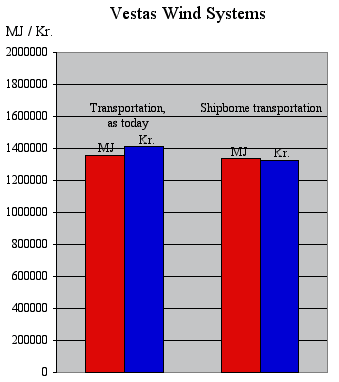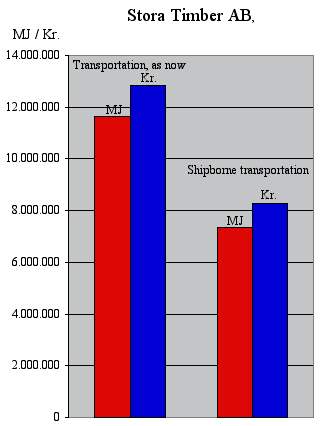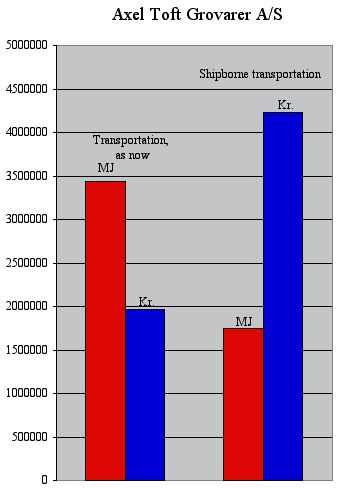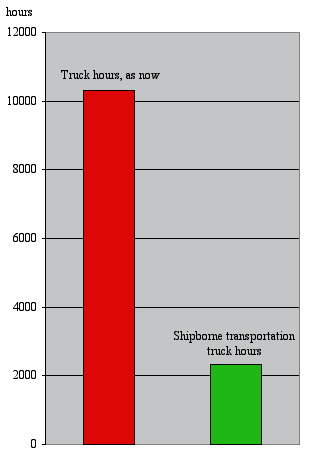XTitelX
English Summary
In this report an investigation is carried out of the energy consumption, environmental emissions and economical aspects, related to transportation of goods by 3 Danish companies.
The report describes how transportation of goods is done today, what this means in use of energy, emissions of air pollutants and cost. A comparison is then made to the same parameters if the companies made as much use as possible of seaborne transportation.
The participating companies was chosen to cover a broad spectre of Danish industry, both by means of type of goods to be transported, over what distances and by what means of transportation the transport are conducted today.
The 3 transport scenarios:
- Transportation of 36 windmills from Denmark to Foggia, Italy.
- Transportation of 60.000 m3 timber from Sweden to Denmark (1997).
- Transportation of 45.000 ton of raw material for the production of feed for live stock (1997).
VESTAS WIND SYSTEMS A/S
The transportation of 36 windmills from Jutland to Foggia, in the southeastern part of Italy is done by train and truck. The seaborne transportation uses truck from the producer in Denmark to a Danish port, Danish port to Italy by short sea shipping, and the last stretch from the Italian port of Manfredonia to the site by truck.

Energy consumption and costs shown as it is today, and when optimised as shipborne transportation.
STORA TIMBER AB
Transportation of 60.000 m3 of timber from 4 saw mills in Sweden to Denmark. The transportation is today done by train (70%), truck (20%) and ship (10%). At 3 of the 4 mills it is possible to load directly onto ships. From the 4th mill feeder truck are used to the port facilities. Distribution from Danish ports to users will be done by truck.

Energy consumption and costs shown as it is today, and when optimised as shipborne transportation.
AXEL TOFT, FEED A/S
Transportation of 45.000 ton of feed from several Danish locations to the producer.
Shipborne transportation will be done by coasters from major ports to the port nearest the producer. From this port the raw material is lifted by truck.

Energy consumption and costs shown as it is today, and when optimised as shipborne transportation
Conclusions and emissions
As shown in the diagrams, it is obvious that it in two of the three cases is possible to reduce the energy consumption, by transporting as much as possible of the goods by ship. When energy consumption is reduced the emissions of air pollutants will in general also be reduced, as these parameters are related.
The emissions of SO2 will not be reduced, due to the fact that the calculations are done from the assumption that bunkers used by ships have a sulphur content of 1 %. A sulphur content of 1 % must be considered as "not unnormal" aboard ships today. A sulphur content of 1 % is 10-20 times higher than the sulphur content in fuel used by trucks or trains.
In the case considering transportation of windmills from Denmark to Italy the energy consumption and emissions of CO2 is on the same level. Emissions of the other considered environmental parameters is higher than today if shipborne transportation is used.
Cost
The cost of transportation if as much as possible is done by shipborne transportation is as shown below:
| Vestas Wind Systems: | 94 % of the present expenses. |
| Stora Timber: | 64 % of the present expenses. |
| Axel Toft: | 215 % of the present expenses. |
Reduction of truck hours "on the road"
The main reason to shift transportation of goods from land to sea, is the possibility of reducing the energy consumption end emissions of air pollutants. Furthermore shifting transportation from land to sea means that it is possible to reduce the load of heavy traffic on the road system. Today the mentioned transport scenarios result in the use of app. 10.000 truck hours. If sea borne transportation is used, this number is reduced to app. 2.000 hour, or a reduction of 77 %.

Necessary truck hours for transportation as done today, and how it would be if as much as possible of the goods were transported by ship.
Green accounts / Life Cycle Analysis
One new aspect not to be overseen from an environmental point of wiew, is the matter of green accounting and life cycle analysis (LCA) for the transported products. These "environmental accounts" might have a positive affect on the market value of "green transportation" even if the economical aspects are taken into consideration.